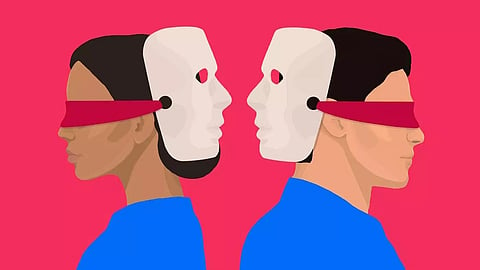
- Home
- Live Blog
- Breaking News
- Top Headlines
- Cities
- NE News
- Sentinel Media
- Sports
- Education
- Jobs

Gender blindness, a concept that minimizes the significance of gender distinctions, is often advocated as a solution to address gender inequality in various fields. At its core, gender blindness seeks to ignore gender disparities, operating under the belief that treating everyone equally—without considering gender—could level the playing field. While this idea has merits in certain contexts, it also reveals significant limitations, particularly when it comes to fostering true gender equality in both the workplace and broader society.
Before diving into the impact of gender blindness, it’s important to clarify the concept. Gender blindness refers to the deliberate ignoring of gender differences, either by treating everyone the same or not acknowledging the role gender plays in shaping people's experiences. On the other hand, gender neutrality focuses on creating inclusive environments where gender is recognized but not a determining factor in decisions or opportunities. Gender neutrality acknowledges that differences exist and strives to reduce biases based on these distinctions.
While controversial, gender blindness has demonstrated certain benefits in promoting gender equality. In particular, it has been found to increase confidence in women and gender minorities, especially in male-dominated industries. For instance, a key finding in psychological studies suggests that gender blindness can help women overcome ingrained societal gender roles that portray men as assertive leaders and women as passive nurturers.
In several studies, researchers discovered that women, when presented with gender-neutral materials, began to identify more with traditionally masculine traits like "dominant" and "forceful." This shift in perception boosted their self-confidence and willingness to take on leadership roles or speak up in male-dominated settings, such as business and management.
Interestingly, gender blindness did not have the same effect on men, who already tend to be more confident in their abilities. As such, researchers suggest that by using gender blindness techniques to simultaneously raise women's confidence while slightly lowering men's, we could close the gender confidence gap and promote greater equality in the workplace.
Additionally, gender blindness has proven effective in combating gender biases in certain sectors, particularly in STEM fields (Science, Technology, Engineering, and Mathematics). Studies have shown that when researchers were unaware of the gender of applicants, they were less likely to rank female candidates lower than their male counterparts based on assumed incompetence. Gender-blind techniques helped reduce the impact of gender bias, making STEM professions more accessible to women and nonbinary individuals.
Despite its potential benefits, gender blindness has several limitations that hinder its effectiveness in achieving gender equality. The primary concern is that it ignores the history of gender discrimination, which is deeply entrenched in societal structures. By disregarding gender altogether, gender blindness fails to address the root causes of inequality, such as sexism and transphobia, which continue to oppress cisgender women, nonbinary individuals, and transgender people.
For example, in some studies, gender-blind policies designed to promote workplace flexibility failed to improve gender equality. In organizations where gender-blind policies were implemented, both men and women acknowledged that flexible work arrangements were primarily used by women with families. This expectation led to a “second shift” for women—additional household responsibilities after their formal workday. Despite gender-blind policies, women often had to choose between advancing in their careers or forgoing flexible work options to avoid being seen as less committed.
Such policies inadvertently reinforced traditional gender roles and expectations, contributing to a situation where women felt pressured to conform to outdated ideas of gendered work.
Given the limitations of gender blindness, scholars and activists argue that gender neutrality is a more effective approach. Unlike gender blindness, gender neutrality doesn't ignore gender differences; instead, it embraces them while aiming to eliminate biases that favor one gender over another. It focuses on institutions and policies, promoting equality without disregarding the importance of gender as part of a person’s identity.
Gender-neutral policies aim to create a workplace culture where gender is recognized and treated fairly. Rather than denying the existence of gender disparities, gender neutrality acknowledges the historical and current challenges that individuals face due to gender bias. By actively addressing gender discrimination, gender-neutral policies work to reduce these biases while promoting inclusivity.
In addition to benefiting cisgender women, gender neutrality also serves the needs of nonbinary and transgender individuals, who often face discrimination and lack recognition in gender-blind environments. By implementing gender-neutral policies, organizations can create spaces where people of all gender identities feel valued and supported.
Adopting gender-neutral policies and perspectives in the workplace involves a conscious effort to educate and raise awareness about the role gender plays in shaping experiences. Organizations should provide training on recognizing and combating gender biases, ensuring that gender-neutral policies are not merely symbolic but effectively address the inequalities people face.
Furthermore, gender-neutral practices can help reduce the structural barriers that often prevent women, transgender, and nonbinary individuals from advancing in their careers. This includes ensuring equal access to mentorship, career development opportunities, and leadership roles—without the influence of gendered expectations or stereotypes.
While gender blindness can offer temporary relief from overt gender biases, its long-term effectiveness in promoting true gender equality is limited. By overlooking the complexities of gender identity and the systemic inequalities that persist in society, gender blindness may inadvertently perpetuate discrimination. Instead, gender neutrality—which recognizes and addresses gender disparities while fostering inclusivity—offers a more holistic and sustainable approach to achieving gender equality in the workplace and beyond. As we continue to evolve toward a more inclusive society, understanding the differences between gender blindness and gender neutrality will be key to building equitable environments for all individuals, regardless of gender identity.
Also Read: Heaven, Wait --- Hauntingly Beautiful
Also Watch: